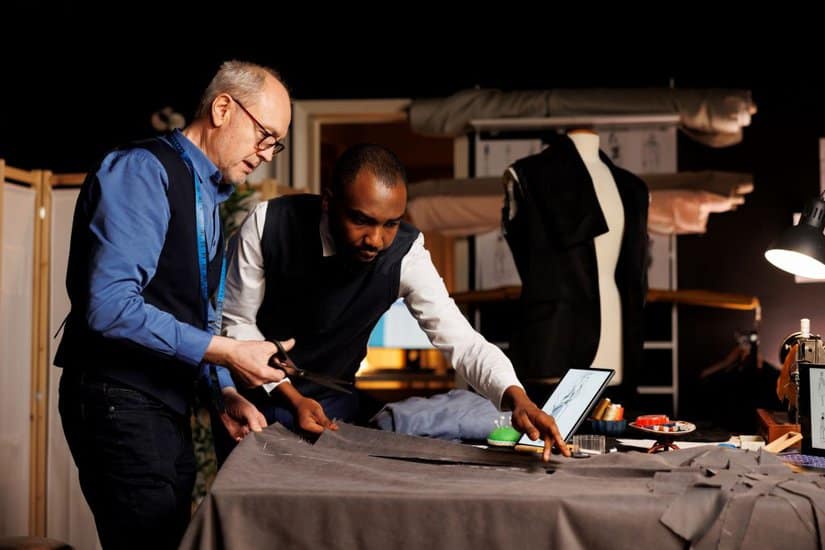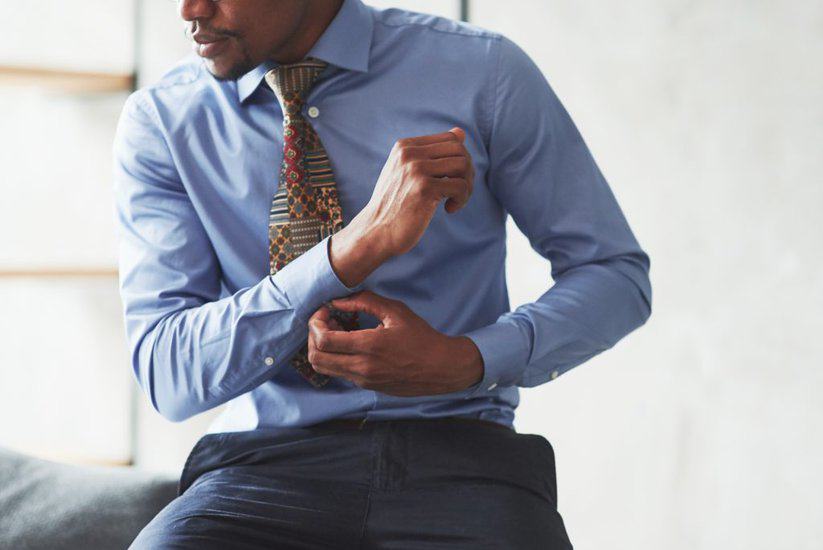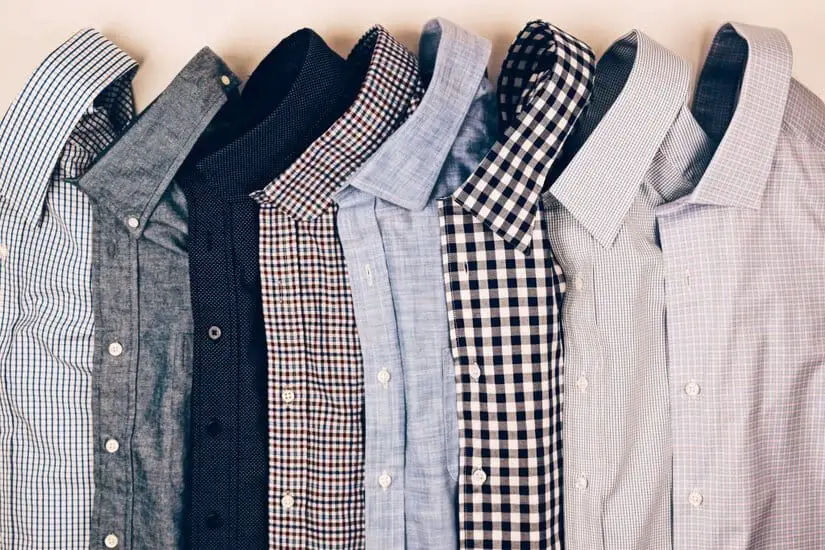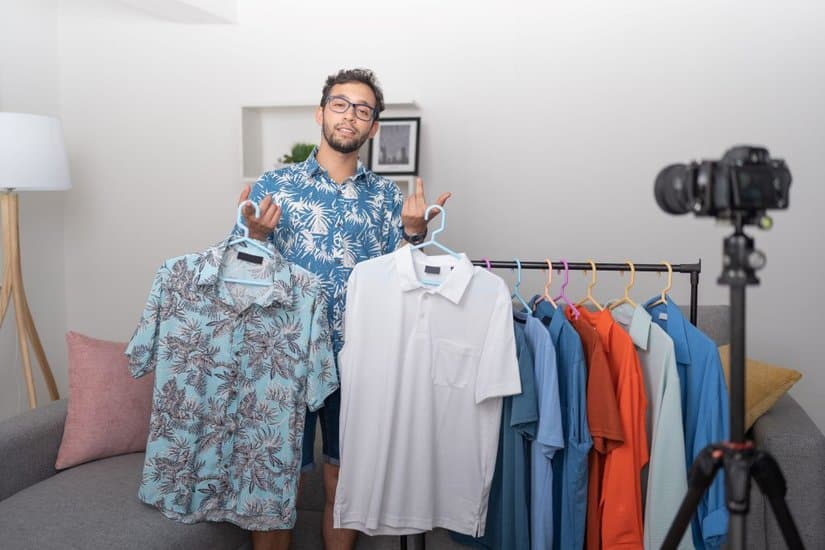Determining the proper sleeve length of a dress shirt is an essential aspect of achieving a well-tailored appearance. Many men struggle with sleeves that are either too long or too short, which can detract from the overall sophistication of their outfit.
When dress shirt sleeves extend past the hinge of the wrist, it’s a telltale sign that they may be too long. This not only affects the look but also the comfort and functionality of the shirt.
If you find yourself constantly adjusting shirt sleeves or feeling swamped in fabric, it indicates a need to reassess the fit. It’s important to understand that sleeve length is just one part of the equation; cuff size and the way the shirt interacts with the rest of your attire also play crucial roles.
Before resorting to tailoring, consider the style of the dress shirt and how you plan to wear it, as different outfits may require variations in sleeve length for a desired look.
Key Takeaways on Are My Dress Shirt Sleeves Too Long?
- Proper sleeve length is key to a polished look.
- Excess sleeve length can compromise comfort and functionality.
- The right fit involves sleeve length, cuff size, and overall shirt style.
Check out these other popular picks:
- Which Shirts Should Be Tucked In?
- How Do You Button a Dress Shirt?
- When Should You Wear a Cutaway Collar?
Understanding Dress Shirt Sleeve Length
When assessing the sleeve length of a dress shirt, look for a specific fit that signals the shirt is tailored correctly for my arms. The ideal dress shirt sleeve length ends at the base of my thumb when my arms are at my sides.
This allows for a small amount of the shirt cuff to show under a jacket. Long sleeves that extend past the base of the thumb are often too long and can make the shirt look oversized.
To measure sleeve fit, I start from the center back of the neck, across the shoulder, and down to the end of the cuff. If I find the sleeve measurement aligns with this end point, I’ve found a proper dress shirt length. A well-fitted sleeve will allow for movement without pulling the cuff up my arm.
Here’s a simple checklist to ensure my dress shirts fit well:
- Shoulder Seam: It should align with the end of my shoulder.
- Cuff Size: It should be tight enough so it doesn’t slide off my wrist.
- Sleeve Length: The cuff should end where my palm begins.
If my cuff is hiding under my jacket’s sleeves or I have to fold the cuff to expose my watch, it’s evident my sleeves are too long. Adjusting the sleeve length is a quick fix tailors can accomplish, ansuring my dress shirts compliment my silhouette rather than detract from it.
Assessing Sleeve Length: The Proper Fit

When I’m buying or fitting a dress shirt, I pay close attention to the sleeves because they’re a vital element in achieving a polished appearance. To ensure proper sleeve length, I start by checking the shoulder seam, which should sit exactly at the edge of my shoulder. This is essential because it serves as the foundation for how the rest of the sleeve will fit.
Sleeve Measurement: For an accurate sleeve length, I make sure the cuff ends approximately 1/2 inch below my wrist bone. This allows for a small portion of the shirt cuff to be visible beyond the jacket sleeve. It’s a detail that I believe signifies a well-fitted shirt.
- Cuff Fit: The cuff should be snug around my wrist without sliding over my hand. I adhere to the rule that I should be able to fit one or two fingers between my wrist and the cuff for a comfortable yet secure fit.
Checking the Fit: I check the fit while moving my arms; a well-fitted sleeve will keep the cuff near the wrist bone even when I extend my arms. If the cuffs are too long, they’ll engulf my hand, whereas if they’re too short, my forearm will be exposed, which I avoid for formal settings.
- Sleeve Taper: Sleeves should taper slightly from the shoulder to the wrist, following the natural line of my arm without being too tight or too baggy.
To sum up, I ensure that each dress shirt sleeve articulates a balance between comfort and formality, providing sufficient movement while also displaying the meticulous nature of my personal style.
The Role of Cuffs in Sleeve Length
When considering shirt sleeve length, one crucial element I always advise clients to consider is the cuff. The cuffs serve as a visual ending point of the sleeve and they should rest comfortably at the base of the thumb when arms are at your sides.
Ideally, when I’m wearing a jacket, a French cuff or regular cuff should allow for a sliver of fabric – about ¼ to ½ inch – to extend beyond the jacket’s sleeves. This small exposure is both aesthetically pleasing and functional, allowing the shirt to move naturally with the body without pulling back into the jacket sleeve.
The correct cuff size should be snug enough to not slide off over the wrist but loose enough to fit one or two fingers between the cuff and the wrist. This ensures the shirt lays properly and prevents the cuff from moving too far over my hand. It’s also key for wrist accessories; if I’m sporting a watch or cufflinks, the cuff needs to accommodate these without being too restrictive or overly loose.
A traditional French cuff is a choice I recommend for formal occasions. It’s doubled back and fastened with cufflinks, adding an element of style. However, for a less formal touch that still retains elegance, a faux French cuff, which also uses cufflinks but isn’t folded back, can be an option.
| Cuff Style | Description |
| French Cuff | Formal, requires cufflinks, is folded back. |
| Faux French Cuff | Less formal, uses cufflinks, not folded back. |
| Regular Cuff | More casual, fastened with a button. |
In conclusion, cuffs are integral not just for style but for ensuring proper fit and movement of the dress shirt. Paying attention to details such as the cuff size and the placement around the wrist bones will ensure a polished and comfortable fit.
When to Tailor Your Dress Shirt Sleeves

Identifying a Perfect Fit: My dress shirt sleeves are just right when the cuffs end at the base of my thumb when my arms are at my sides. This ensures a smart look with or without a jacket.
Signs You Need Alterations:
- Excess Length: If the cuffs extend beyond the heels of my hands, it’s time to visit my tailor.
- Balance Issues: I consider alterations if the sleeve length is uneven or if one sleeve feels tighter than the other.
Tailoring Solutions:
- Shortening Sleeves: My tailor can shorten the sleeves if they’re too long. It’s a straightforward fix that significantly improves the shirt’s appearance.
- Adjusting Cuffs: Sometimes, all that’s required is to adjust the position of the cuff buttons for a better fit around my wrists.
Cost and Consideration: I keep in mind that the cost of alterations should be proportional to the shirt’s value. Simple adjustments like cuff button repositioning are cost-effective, but I’d ponder before spending extensively on a low-cost shirt.
Preventative Measures: To avoid the need for alterations, I opt for shirts that match my sleeve length or consider made-to-measure options.
By being attentive to these aspects, I ensure my dress shirts complement my physique and professional appearance without being baggy or uncomfortable. It’s these details in clothing alterations that can transform a good outfit into a great one.
Styles and Fits of Dress Shirts
When selecting a dress shirt, I focus on the main styles and fits to ensure a sharp look. Style-wise, dress shirts come in a variety of options, but the most crucial aspect to consider is the collar. A classic point collar is versatile and suits most occasions, while a cutaway collar offers a modern aesthetic that pairs well with a wider tie knot.
In terms of fit, dress shirts primarily fall into three categories:
- Classic Fit: Generous through the chest and waist, this fit is comfortable and traditional.
- Slim Fit Shirt: This style is tapered through the torso, offering a fitted, sleek silhouette ideal for slim body types.
- Modern Fit: A middle ground between the other two, giving a flattering shape without being too tight.
When checking the fit, I ensure that the shirt sleeves are the right length by following a simple guideline: the cuff should end where my palm begins, allowing 1/4″ to 1/2″ of the shirt cuff to show beneath the jacket sleeve.
The choice of fabric also plays a significant role in the overall appearance and comfort of the dress shirt. A breathable and crisp cotton or cotton blend is my preference, as it offers durability and a polished look.
It’s important for the dress shirt to not only reflect personal style but also to fit properly; a well-tailored shirt makes a marked difference in creating a flattering ensemble. I take the time to try on different brands as each may have slight variations in sizing, ensuring my choices are both stylish and proportional to my body.
Dress Shirts with Different Outfits

When I select a dress shirt to pair with different outfits, whether it’s for the office or a formal event, I always consider the sleeve length and how it complements the overall look. Especially when it comes to layering with a suit jacket or sport coat, the right sleeve length can make or break an ensemble.
- With a Suit Jacket: The general rule I follow is that when I have my suit jacket on, about ¼ to ½ inch of my shirt cuff should be visible. This subtle detail adds a touch of elegance and ensures that my sleeves are not too long.
- Adding a Tie: For a polished office look, I make sure my dress shirt fits well at the collar so that the tie sits nicely and the proportions remain balanced. A well-fitted sleeve keeps my shirt from looking oversized when worn with a tie.
- Sport Coat for Casual Smart: If I am wearing a sport coat for a less formal setting, I still maintain that slight cuff exposure. It is a good indicator that my sleeves are at the right length, even in a more relaxed environment.
- Layering: Layering during colder months often means wearing a jumper over my dress shirt. In this case, I ensure that my shirt sleeves don’t bunch up under the jumper and that the cuffs peek out just a bit at the wrists.
Shirt Sleeve Troubleshooting & Care
When I encounter wrinkles in my dress shirt sleeves, my go-to method is a quality steam iron. Ensuring the iron isn’t too hot to avoid damage, I carefully press out the creases, which helps my sleeve keep a crisp and professional look.
Dealing with excess fabric can be more challenging. If my shirt sleeves feel baggy, I consider having them tailored for a more contoured fit. Temporary solutions like strategically rolling the sleeves or wearing a well-fitted jacket can also alleviate this issue momentarily.
If my sleeves are ill-fitting—usually displaying either too much or too little length—I assess the proper sleeve length, where the cuff should rest at the base of my thumb when my arms are at my sides. An alteration is sometimes necessary to correct sleeves that are too long or too short.
Understanding shrinkage is critical. I always follow washing and drying instructions to prevent unwanted changes in fabric size. If shrinkage occurs despite my efforts, I visit my tailor to see if any adjustments can be made to salvage the fit.
In a pinch, sleeve garters are a practical accessory I use. They allow me to adjust the length of my sleeves on the fly and maintain a tidy appearance throughout the day.
Here is my simple care checklist:
- Steam iron sleeves to remove wrinkles.
- Tailor excess fabric for a better fit or use temporary methods.
- Correct ill-fitting sleeves with a professional alteration if needed.
- Follow laundering instructions closely to prevent shrinkage.
- Utilize sleeve garters for immediate sleeve length adjustments.
By attentively managing these aspects, I ensure my dress shirt sleeves maintain the sharp look and proper fit they require.
Selecting the Right Dress Shirt

When I choose a dress shirt, the fit is paramount. I consider the shirt length to ensure it stays tucked in without bunching up, which is particularly important for shorter guys who want to avoid looking swamped in fabric.
Collar size is vital too. I make sure there’s just enough room to breathe when the top button is fastened. For a collar that will frame my face well, I opt for a cut that complements my face shape. Button-downs are versatile in this aspect and can be a good choice for various settings.
Moving on to shoulder fit, it’s imperative that the seam sits just at the edge of my shoulders. This defines the structure of the shirt and ensures I look put-together.
Here’s a quick checklist I use:
- Shirt length: Falls just enough to stay tucked in.
- Collar size: Allows one finger between my neck and collar.
- Shoulder fit: Seam sits at the edge of the shoulder.
A well-selected dress shirt accentuates my frame without restricting movement. It’s a balance of comfort and style, making sure I look sharp and feel confident.
Understanding Off-the-Rack vs Tailored

Off-the-rack shirts are mass-produced based on standard sizing. They are convenient and readily available, making them a popular choice for many. However, a well-fitted dress shirt is not guaranteed due to the generalization of sizes. Sometimes, I may find the sleeves are too long or the fit around the chest and waist is not quite right.
On the other hand, tailored shirts are adjusted or made to fit the individual’s specific measurements. When I visit tailors, they measure every relevant part of my upper body to ensure the shirt will fit closely and comfortably.
Here’s a quick comparative view:
| Feature | Off-the-Rack | Tailored |
| Size Availability | Standard sizes | Custom measurements |
| Fit | Generic | Personalized |
| Price | Usually less expensive | May cost more |
| Convenience | Immediate purchase | Requires fitting session |
| Customization | Limited | Extensive |
| Quality | Can vary | Typically higher due to attention to detail |
Choosing a tailored shirt often means I’m investing in a garment that will look and feel better because it’s made to fit my exact dimensions. Although it may require an initial fitting and a higher upfront cost, the result is a shirt that accommodates all my proportions, from neck to waist to sleeve length, eliminating the issue of sleeves that may be too long or a torso that feels too small.
Frequently Asked Questions
In my experience, proper fit is essential for dress shirt sleeves. They should look tailored to your arms and allow for freedom of movement without excessive fabric. Now, let’s address some common questions about dress shirt sleeves.
How should dress shirt sleeves fit when wearing?
Dress shirt sleeves should fall just below the wrist bone, allowing for about a half-inch of the shirt cuff to be visible beyond the jacket sleeve. The sleeve should follow the natural shape of your arm and not be too tight or too loose.
What are the signs that dress shirt sleeves are excessively long?
If your shirt sleeves are bunching at the wrist or you can’t see your wristwatch without pulling the fabric back, they are too long. Another sign is if the cuff extends beyond the heel of your hand when your arms are relaxed.
Can you alter dress shirt sleeves for a better fit without sewing?
For a temporary solution, shirt sleeve garters or bands can be used to hold the sleeves at the desired length. Folding or rolling the sleeves is an informal adjustment that can reduce their length.
How can you quickly adjust sleeves that are too long on a dress shirt?
Quick adjustments include using sleeve roll techniques such as the master or casual roll to shorten the sleeves temporarily. Another method is using a cufflink to pin the fabric up inside the sleeve, hiding the excess length.
What is the proper length for dress shirt sleeves?
The proper length for dress shirt sleeves is such that the cuff ends where the palm of your hand begins, allowing the shirt to extend just beyond the wrist bone. This Proper Dress Shirt Sleeve Length: Measurement & Fit guide explains the process in more detail.
What are some common methods to fix dress shirt sleeves that are too short?
To fix sleeves that are too short, tailor them by adding fabric or moving the existing button to tighten the fit around the wrist. Fabric inserts or contrasting cuffs can also provide additional length and a fashion-forward look.

Samoel Ovanessian is the founder and creator of StylishAlpha.com – a website dedicated to men’s fashion. As a proud owner of more than 200 ties, he loves digging through new clothing combinations for everyday use, formal events and even just for fun. You can read more about Samoel here.

